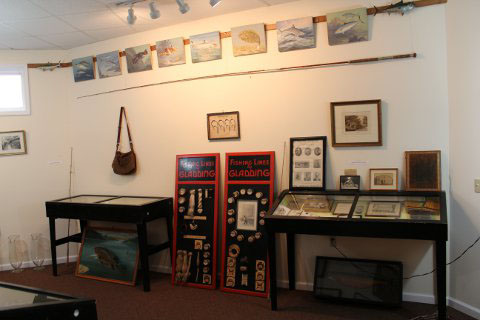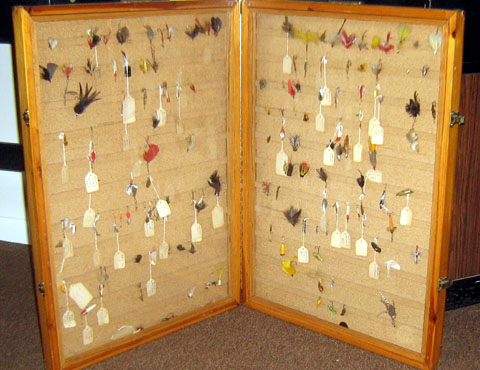
| About Us: The Pulaski Salmon River International Museum | ||||||||
|---|---|---|---|---|---|---|---|---|
Come explore the thousands of items which were originally on display at the Gladding International Sports Fishing Museum in South Otselic, NY from 1972 until the mid 1980’s. This museum was the first ever in the country. The Gladding corporation started in 1816 as a fishing line manufacturer and within a short time became one of the world's largest fishing line manufacturers in the world. In 1972 Governor Nelson Rockefeller declared South Otselic ‘The Fishing Line Capitol of the World”. In the 1980’s Gladding fell upon hard times and eventually went bankrupt. Everything was sold at auction except this wonderful collection. This became property of The Oswego Chamber of Commerce and was transferred to the Oswego International Sport Fishing Collection Inc. and was housed at SUNY Oswego for over 16 years. For many years they sought financial support and a permanent location in which to display this magnificent collection. The Pulaski / Eastern Shore Chamber of Commerce saw the significance of this collection and decided that Pulaski would become its new home. In 2003 they began building the museum and the rest is history. Now the museum is available for you to view, and enjoy. Come take a guided tour or take advantage of our self guided tour.
Because the Gladding Corporation was the original owner of the collection, many of the exhibits and artifacts are products manufactured by Gladding Corporation or were manufactured by one of the companies acquired by Gladding. Companies like Glen Evans, Magic Snell, Payne Rod Company, Horrocks Ibbotson, South Bend, Paw Paw and many others. The museum also has many early books about fishing including the book, “Treatyse of Fysshnge” by Dame Juliana Berners. This book is believed to be the first book written on sport fishing.
The walls are decorated with beautiful paintings by Maynard Reece, Dave Blossom and Currier and Ives. Many of these paintings were used in Outdoor life and by South Bend in their magazines and advertising. There are also taxidermies of all types of fish species and wildlife. Gladding sponsored a contest called “Tall Tails” in the seventies. The purpose of the contest was to have people send outlandish fish stories. The entries would be evaluated by people such as Tennessee Ernie Ford. The winner would receive an all expense paid Fishing Trip and many prizes the majority manufactured by the Gladding Corporation and its subsidiaries. We have a link at the top of this page called "Freds Fish Tales Blog". Here you can sample what a tall tale is, just be careful not to get hooked.
Rods, Reels, Lures, Hooks and Spears The Museum has a large collection of rods, lures, reels and hooks that date as far back as the 16th century. In the nineteenth century New York State had the most manufactures of fishing tackle. In fact J.T. Buel a manufacturer located in Whitehall, NY has the very first patented lure in the United States. The northern regions of New York has several manufactures like, W.D. Chapman, Dey, Skinner and Northern Specialties. One of the most exciting lure collections the museum has is of a Moonlight Bait Company Salesman sampler carrying case full of lures. We even have the salesman's card with it.
There were also many reel makers, like Yaman and Erb, Rochester, NY; Killian, Baldwinsville, NY; Edward Von Hofe, Brooklyn, NY; Square Stamping Company, Barneveld, NY; Billing- hurst, Rochester, NY; Martin, Mohawk, NY; Horrocks and Ibbotson, Utica, NY; the list goes on and on. The museum also has many unique rod and reel combinations as well split bamboo, steel, and wood. Of all the fishing rods the museum has in it’s collection, three stand out. One is a fly rod made for Charles Ritz the founder of the Ritz Hotels. The other fly rod is a Hardy Rod made with sterling silver and inlayed with ebony and other precious woods and metals. This rod is believed to have been owned by a king. The museum also has many eel, fish and frog spears, minnow buckets, nets, decoys, creels, hook displays, books and furniture. As you explore the collection you will find yourself imagining the days where a stick, line, hook and cork would do the trick. If only the tackle could tell you their stories of the fish they’ve seen, landed and lost. What a tale they would tell. The museum is open seasonally in September from 10 am to 4 pm on Thursdays, and from 11 a.m. to 2 p.m. on Saturdays. Volunteers are available to help with research and questions at the regular work sessions on Tuesdays from 9 a.m. to noon. |







